 Purdue University - Extension - Forestry and Natural Resources
Purdue University - Extension - Forestry and Natural Resources
Got Nature? Blog
 Tulip poplar (Liriodendron tulipifera) is one of the largest trees in Indiana and the eastern portion of the country. Tulip poplar reaching heights in excess of 50-60 m (160-200 ft) with a diameter at breast height (dbh) of 3 m (10 ft) have been reported while the majority of these eastern giants are between 20-30 m (70-100 ft) tall. This tree is fast-growing, has few health problems, and can live upwards of 200 years.
Tulip poplar (Liriodendron tulipifera) is one of the largest trees in Indiana and the eastern portion of the country. Tulip poplar reaching heights in excess of 50-60 m (160-200 ft) with a diameter at breast height (dbh) of 3 m (10 ft) have been reported while the majority of these eastern giants are between 20-30 m (70-100 ft) tall. This tree is fast-growing, has few health problems, and can live upwards of 200 years.
The tree looks best between April and June when it begins to flower as it is covered with large pale green to yellow flowers with an orange band encircling the tepals. These flowers are brimming with nectar and draw in large quantities of bees, birds, and butterflies. The tree has been deemed so magnificent that it is the state tree of Indiana, Kentucky, and Tennessee.
American ginseng (Panax quinquefolius) is an herbaceous perennial member of the ivy family that has traditionally been used in North America by Native Americans for its medicinal properties and cultivated in China for use in herbal remedies. In years past, American ginseng was widespread throughout the eastern United States until overharvesting, habitat fragmentation, urbanization, and deer browsing decimated wild populations.
Though not scientifically proven, ginseng is believed to remedy numerous health conditions such as inflammation, the flu, cancer, insomnia, erectile dysfunction, and hangovers. The herb has become one of the most popular unproven remedies in the world.
A new study noted that wild populations of American ginseng could benefit from being planted near tulip poplar. The data stated that new strategies need to be pursued in conservation efforts to save the rare American ginseng plant. The study advised that planting American ginseng on sites equally suited to tulip trees had the potential to increase outplanting success. The authors recommended planting in isolated, mostly closed canopy areas free of disturbances (trespassers, timber harvesting, large deer populations) and against planting in sites with wild sarsaparilla (Lindera benzoin).
Resources:
Ginseng: Old Crop, New Directions – Purdue University Department of Horticulture
Ginseng – Indiana Department of Natural Resources
American Ginseng – U.S. Fish & Wildlife Service
Liriodendron tulipifera – The IUCN Red List of Threatened Species
Can putative indicator species predict habitat quality for American ginseng? – Ecological Indicators
Shaneka Lawson, Plant Physiologist
Purdue University Department of Forestry & Natural Resources

Recent Posts
- Farmers Helping Hellbenders RCPP Program Accepting Applications
Posted: May 1, 2024 in Aquaculture/Fish, Forestry, How To, Wildlife, Woodlands - Extension Specialist Brian MacGowan Receives Hoosier Wildlife Award
Posted: in Forestry, Wildlife - MyDNR – First positive case of chronic wasting disease in Indiana
Posted: April 29, 2024 in Alert, Disease, How To, Safety, Wildlife - Publication – Introduction to White-tailed Deer Impacts on Indiana Woodlands
Posted: April 28, 2024 in Forestry, Land Use, Plants, Publication, Wildlife, Woodlands - Publication – Understanding White-tailed Deer and Their Impact on Indiana Woodlands
Posted: in Forestry, Land Use, Plants, Publication, Wildlife, Woodlands - Publication – Monitoring White-tailed Deer and Their Impact on Indiana Woodlands
Posted: in Forestry, Land Use, Plants, Publication, Wildlife, Woodlands - Publication – Managing White-tailed Deer Impacts on Indiana Woodlands
Posted: in Forestry, Land Use, Plants, Publication, Wildlife, Woodlands - Report Spotted Lanternfly – Purdue Landscape Report
Posted: April 10, 2024 in Alert, Forestry, Invasive Insects, Plants, Wildlife, Woodlands - Declining Pines of the White Variety – Purdue Landscape Report
Posted: in Alert, Disease, Forestry, Plants, Wildlife, Woodlands - Are you seeing nests of our state endangered swan? – Wild Bulletin
Posted: April 9, 2024 in Alert, Forestry, How To, Wildlife
Archives
Categories
- Alert
- Aquaculture/Fish
- Aquatic/Aquaculture Resources
- Ask the Expert
- Christmas Trees
- Community Development
- Disease
- Drought
- Forestry
- Forests and Street Trees
- Gardening
- Got Nature for Kids
- Great Lakes
- How To
- Invasive Animal Species
- Invasive Insects
- Invasive Plant Species
- Land Use
- Natural Resource Planning
- Nature of Teaching
- Plants
- Podcasts
- Ponds
- Publication
- Safety
- Timber Marketing
- Uncategorized
- Urban Forestry
- Webinar
- Wildlife
- Wood Products/Manufacturing
- Woodland Management Moment
- Woodlands